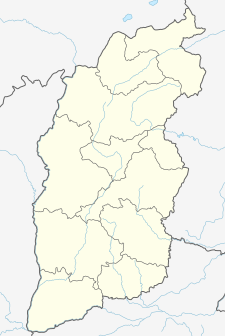Pusading
| Pusading | |
|---|---|
菩萨顶 | |
 The Mahavira Hall at Pusading | |
| Religion | |
| Affiliation | Buddhism |
| Sect | Gelug |
| Location | |
| Location | Taihuai, Wutai County, Shanxi |
| Country | China |
| Geographic coordinates | 39°01′09″N 113°36′04″E / 39.019046°N 113.601219°E / 39.019046; 113.601219 |
| Architecture | |
| Style | Chinese architecture |
| Date established | Northern Wei (386–534) |
The Pusading (simplified Chinese: 菩萨顶; traditional Chinese: 菩薩頂; pinyin: Púsàdǐng; lit. 'Bodhisattva Summit') is a Buddhist temple located in Taihuai Town of Wutai County, Shanxi, China.[1] The temple structure is considered the best of all temples in Mount Wutai.
History
The legend says that Manjushri revealed himself and preached at the summit of Mount Wutai, hence the name "Bodhisattva Summit Temple" (菩萨顶). It is also known as "Spiritual Black Eagle Peak" (灵鹫峰) due to its geographical position similar to the Lingjiu Peak described by Sakyamuni in the city of Rajgir northeast of the Kingdom of Magadha.[2]
Northern Wei dynasty
Pusading was first established in the reign of Emperor Xiaowen of Northern Wei (467–499) in the Northern Wei (386–534) dynasty and initially called "Great Temple of Manjushri" (大文殊院).[3]
Tang dynasty
In 631, in the 5th year of the Zhenguan period of the Tang dynasty (618–907), Buddhist monk Fayun (法云) rebuilt the temple and renamed it "Zhenrong Temple" (真容院).[3]
Song dynasty
During the Jingde period (1004–1007) of the Northern Song dynasty (960-1127), Emperor Zhenzong (997–1022) bestowed a plaque with "Fengzhen Pavilion" (奉真阁) on the temple.[3]
Ming dynasty
In the Yongle period (1403–1424) of the Ming dynasty (1368–1644), the Yongle Emperor changed the name to "Great Temple of Manjushri" (大文殊寺). In 1581, in the 9th year of the Wanli period, the temple was renovated by the government.[3]
Qing dynasty
In 1656, in the 13th year of the Shunzhi period (1644–1661) of the Qing dynasty (1644–1912), the temple converted to Tibetan Buddhism. In 1683, in the 22nd year of the Kangxi period (1662–1722), with the Kangxi Emperor's permission, the roof of Pusading was tiled with yellow glazed tiles.[3]
In June 1908, United States Ambassador to China William Woodville Rockhill and the 13th Dalai Lama talked about strengthening cooperation on the Government of British India and Government of Tibet issue in the temple.[4]
Republic of China
In the spring of 1948, Chen Yi went to Xibaipo via Mount Wutai. He wrote a poem in praise of the beautiful scenery.
People's Republic of China
In 1983, the temple was classified as a "National Key Buddhist Temple in Han Chinese Area".
Architecture

A walkway of 108 stone steps
A walkway of 108 stone steps leads to the summit as if it was a ladder to heaven from the temples below. It is said the 108 stone steps represent 108 worries of mankind, and one has to overcome them one step (one worry) at a time to see the true capacity of Buddha.[2]
Paifang
Under the paifang of shanmen is a plaque with the Chinese characters "灵峰胜境" (灵峰胜境 means beautiful site of Lingjiu Peak) written by the Kangxi Emperor (1654–1722) in the Qing dynasty (1644–1912).[5]
In front of Manjusri Hall, a plaque with "五台圣境" (五台圣境 means beautiful site of Mount Wutai), written by the Kangxi Emperor (1654–1722) in the Qing dynasty (1644–1912), is hung on the stone paifang.[5]
References
- ^ Huang Hong; Ye Jianru; Zhang Jie (2017). Voyage en Chine [Journey to China] (in French). Shanghai: Donghua University Press. ISBN 978-7-5669-1210-7.
- ^ a b Wang Jia (2012), pp. 94–95.
- ^ a b c d e 五台山菩萨顶 [Pusading]. wutaishanfojiao.com (in Chinese). 2005.
- ^ 中美关系史上第一位与达赖喇嘛建立并保持联系的美国外交官. sina (in Chinese). 2017-11-24.
柔克义于1908年6月13日打点行装,由美国驻华公使馆的托马斯•哈斯金斯(Thomas Haskins)陪伴,用了五天时间赶到那里。尽管不在拉萨,这却是一位美国外交官与中国西藏的达赖喇嘛的第一次会见。这位美国驻华公使在五台山的菩萨顶盘桓了整整一个星期,用藏语直接同达赖喇嘛交谈,不需任何人居间翻译。他劝告达赖喇嘛遵从清朝皇帝的旨意,改善与英属印度政府的关系,并将其作为自己政策的基点。
- ^ a b 菩萨顶 [Pusading]. huaxia.com (in Chinese). 2015-02-19. Archived from the original on 2008-10-14. Retrieved 2017-12-18.
Bibliography
- Wang Jia (2012). "Mount Wutai: Bodhisattva Summit Temple". Famous Mountains in China (in English and Chinese). Hefei, Anhui: Huangshan Publishing House. ISBN 978-7-5461-2704-0.
